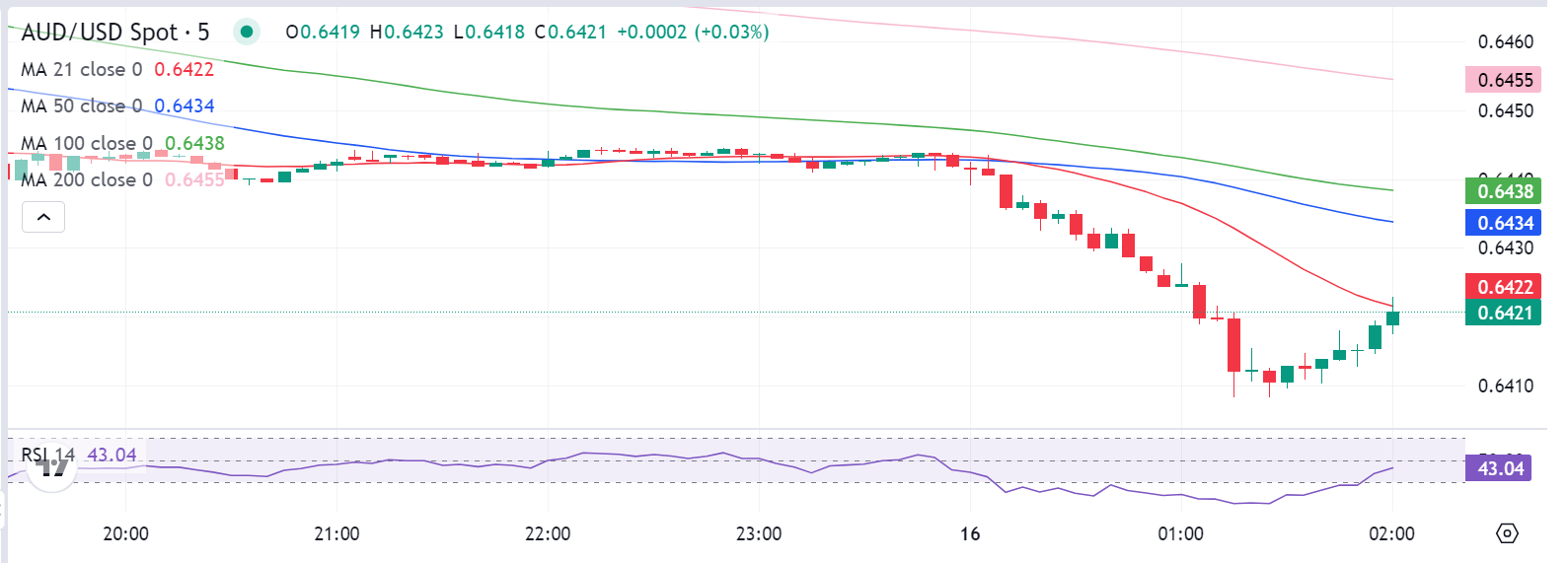China’s economy expanded 5.3% over the year in the first quarter of 2024, as against a 5.2%% growth in the final quarter of 2023, the official data released by the National Bureau of Statistics (NBS) showed on Tuesday. The market consensus was 5.0% in the reported period.
On a quarterly basis, Chinese Gross Domestic Product (GDP) rate increased by 1.6% in Q1 2024 vs. 1.0% registered in the previous quarter.
China’s March Retail Sales YoY, rose 3.1% vs. 4.5% expected and 5.5% prior while the country’s Industrial Production arrived at 4.5% YoY vs. 5.4% estimates and February’s 7.0%.
Meanwhile, the Fixed Asset Investment increased 4.5% YTD YoY in March vs 4.3% expected and 4.2% last.
AUD/USD reaction to China’s data dump
Stronger-than-expected China’s GDP data briefly lifted the Australian Dollar, although the upside appears limited amid unabated US Dollar demand. At the time of writing, AUD/USD is holding its minor upswing to near 0.6430, still down 0.22% on the day.
AUD/USD: 5-minutes chart
Australian Dollar FAQs
One of the most significant factors for the Australian Dollar (AUD) is the level of interest rates set by the Reserve Bank of Australia (RBA). Because Australia is a resource-rich country another key driver is the price of its biggest export, Iron Ore. The health of the Chinese economy, its largest trading partner, is a factor, as well as inflation in Australia, its growth rate and Trade Balance. Market sentiment – whether investors are taking on more risky assets (risk-on) or seeking safe-havens (risk-off) – is also a factor, with risk-on positive for AUD.
The Reserve Bank of Australia (RBA) influences the Australian Dollar (AUD) by setting the level of interest rates that Australian banks can lend to each other. This influences the level of interest rates in the economy as a whole. The main goal of the RBA is to maintain a stable inflation rate of 2-3% by adjusting interest rates up or down. Relatively high interest rates compared to other major central banks support the AUD, and the opposite for relatively low. The RBA can also use quantitative easing and tightening to influence credit conditions, with the former AUD-negative and the latter AUD-positive.
China is Australia’s largest trading partner so the health of the Chinese economy is a major influence on the value of the Australian Dollar (AUD). When the Chinese economy is doing well it purchases more raw materials, goods and services from Australia, lifting demand for the AUD, and pushing up its value. The opposite is the case when the Chinese economy is not growing as fast as expected. Positive or negative surprises in Chinese growth data, therefore, often have a direct impact on the Australian Dollar and its pairs.
Iron Ore is Australia’s largest export, accounting for $118 billion a year according to data from 2021, with China as its primary destination. The price of Iron Ore, therefore, can be a driver of the Australian Dollar. Generally, if the price of Iron Ore rises, AUD also goes up, as aggregate demand for the currency increases. The opposite is the case if the price of Iron Ore falls. Higher Iron Ore prices also tend to result in a greater likelihood of a positive Trade Balance for Australia, which is also positive of the AUD.
The Trade Balance, which is the difference between what a country earns from its exports versus what it pays for its imports, is another factor that can influence the value of the Australian Dollar. If Australia produces highly sought after exports, then its currency will gain in value purely from the surplus demand created from foreign buyers seeking to purchase its exports versus what it spends to purchase imports. Therefore, a positive net Trade Balance strengthens the AUD, with the opposite effect if the Trade Balance is negative.
Information on these pages contains forward-looking statements that involve risks and uncertainties. Markets and instruments profiled on this page are for informational purposes only and should not in any way come across as a recommendation to buy or sell in these assets. You should do your own thorough research before making any investment decisions. FXStreet does not in any way guarantee that this information is free from mistakes, errors, or material misstatements. It also does not guarantee that this information is of a timely nature. Investing in Open Markets involves a great deal of risk, including the loss of all or a portion of your investment, as well as emotional distress. All risks, losses and costs associated with investing, including total loss of principal, are your responsibility. The views and opinions expressed in this article are those of the authors and do not necessarily reflect the official policy or position of FXStreet nor its advertisers. The author will not be held responsible for information that is found at the end of links posted on this page.
If not otherwise explicitly mentioned in the body of the article, at the time of writing, the author has no position in any stock mentioned in this article and no business relationship with any company mentioned. The author has not received compensation for writing this article, other than from FXStreet.
FXStreet and the author do not provide personalized recommendations. The author makes no representations as to the accuracy, completeness, or suitability of this information. FXStreet and the author will not be liable for any errors, omissions or any losses, injuries or damages arising from this information and its display or use. Errors and omissions excepted.
The author and FXStreet are not registered investment advisors and nothing in this article is intended to be investment advice.
Recommended content
Editors’ Picks
AUD/USD sits at weekly lows near 0.6600 amid mixed market mood

AUD/USD is sitting at weekly lows just above 0.6600 in the Asian session on Thursday. Mixed Australian PMIs and cautious markets keep the pair undermined. The Aussie registered losses on Wednesday after the Fed Minutes hinted at raising rates if inflation warranted it.
USD/JPY pulls back from near 157.00 as US Dollar struggles

USD/JPY is reversing a fresh uptick to two-week highs near 157.00 in Asian trading on Thursday. The pair briefly tested the 157.00 threshold on BoJ's steady bond-buying operation. However, a pause in the US Dollar rebound and sluggish US Treasury bond yields drag the pair lower.
Gold price edges lower on Fed's hawkish stance

Gold price extends the decline on Wednesday. The further upside of the yellow metal might be limited, as the FOMC minutes were interpreted as significantly more hawkish than previous releases. The cautious approach of the US Fed to hold its restrictive policy for longer boosts the Greenback broadly.
NEAR protocol could see a rally as it sets out to launch an AI smart contract builder

Near protocol co-founder Illia Polosukhin stated in a social media post on Wednesday plans for NEAR to launch NEAR AI, a user-owned AI system that will allow users to build web3 apps without code on an end-to-end network.
Nvidia Q1 earnings push NVDA stock to new all-time high Premium
Nvidia earnings were a smash hit once again when they arrived after Wednesday's market close. Shares blasted past the former $974 all-time high to reach just under $1,000 per share, up more than 4% afterhours.
